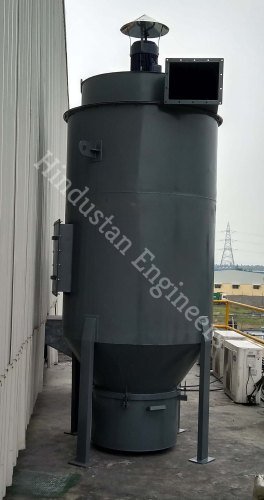Cement dust collector systems, also known as cement dust collectors or cement dust filtration systems, are specifically designed to capture and remove airborne dust particles generated during the production, handling, and transportation of cement and other similar powdery materials. These systems are crucial for maintaining a clean and safe working environment, preventing the release of dust into the atmosphere, and complying with environmental regulations. Here are some key points about cement dust collector systems:
Principle of Operation: Cement dust collectors operate based on the principle of filtration. They use a combination of filters or filter bags to trap and collect the dust particles suspended in the air. The air carrying the dust is drawn into the dust collector system through various intake points, such as dust hoods, ducts, and collection hoppers. The dust particles are trapped by the filters as the air passes through, leaving behind clean air that is then discharged back into the atmosphere. Components of a Dust Collector System: A typical cement dust collector system consists of several key components:
Dust Hoods and Intake Points: These are strategically located openings where dust is generated, such as crusher hopper, conveyor transfer points, and silo vents. The dust hoods or enclosures help to minimize dust release and facilitate proper dust collection.
Ductwork: The ductwork serves as a pathway for transporting dust-laden air from the intake points to the dust collector unit. It is important to design the ductwork system properly to ensure efficient airflow and minimize pressure drop.
Dust Collector Unit: This is the main component of the system that houses the filters or filter bags and the fan or blower. The fan creates a negative pressure inside the collector, pulling the dust-laden air through the filters. The filters capture the dust particles while allowing clean air to pass through.
Filter Cleaning Mechanism: As the filters collect dust over time, they need to be periodically cleaned to maintain their efficiency. Dust collector systems may include various types of cleaning mechanisms, such as pulse-jet cleaning or reverse air cleaning, to dislodge the accumulated dust from the filters.
Dust Disposal System: The collected dust is stored in a separate compartment or hopper within the dust collector unit. It can be discharged through outlets or conveyed to dust disposal or recycling systems.
Types of Filters: Different types of filters are used in cement dust collector systems, including woven fabric filters (filter bags), pleated filters, cartridge filters, and ceramic filters. The choice of filter depends on factors such as the particle size distribution, dust loading, airflow rate, temperature, and moisture content of the dust.
Benefits and Importance: Cement dust collector systems offer several benefits, including:
Improved Air Quality: By capturing and removing airborne dust particles, dust collector systems significantly improve the air quality within the facility, reducing exposure to harmful dust for workers and visitors.
Compliance with Regulations: Dust collector systems help companies meet environmental regulations and standards for air quality control.
Equipment Protection: Dust particles can be abrasive and harmful to equipment and machinery. Dust collector systems help maintain a cleaner environment, reducing the risk of damage to equipment and increasing their lifespan.
Fire and Explosion Prevention: Fine dust particles, if not properly controlled, can create a hazardous environment that is prone to fires and explosions. Dust collector systems mitigate this risk by collecting and containing the dust particles.
Waste Reduction and Recycling: Some cement dust collector systems incorporate dust disposal or recycling systems, promoting waste reduction and recycling efforts. In summary, cement dust collector systems are essential for maintaining a clean and safe working environment in cement manufacturing facilities. They capture and remove airborne dust particles generated during cement production processes, preventing their release into the atmosphere. By using various filtration methods, dust collector systems improve air quality, protect equipment, and comply with environmental regulations. Proper design, sizing, and maintenance of cement dust collector systems are crucial for their effective operation. Consulting with experts in dust collection systems or manufacturers specializing in cement dust collectors can help ensure the proper selection and optimal performance of these systems.

